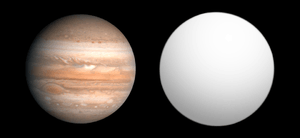WASP-2b
| Exoplanet | List of exoplanets | |
|---|---|---|
 | ||
| Parent star | ||
| Star | WASP-2 A[1] | |
| Constellation | Delphinus | |
| Right ascension | (α) | 20h 30m 54s |
| Declination | (δ) | +06° 25′ 46″ |
| Apparent magnitude | (mV) | 11.98 |
| Distance | 470 ly (144 pc) | |
| Spectral type | K1V | |
| Orbital elements | ||
| Semi-major axis | (a) | 0.03138 (± 0.011) AU |
| Eccentricity | (e) | 0 |
| Orbital period | (P) | 2.15222144 (± 4e-07) d |
| Inclination | (i) | 84.73 (± 0.19)° |
| Time of transit | (Tt) | 2453991.5153 (± 0.00017) JD |
| Physical characteristics | ||
| Mass | (m) | 0.847 ± 0.045 MJ |
| Radius | (r) | 1.079 ± 0.033 RJ |
| Surface gravity | (g) | 3.279 ± 0.036[1] g |
| Temperature | (T) | 1300 ± 54[1] |
| Discovery information | ||
| Discovery date | September 25, 2006 | |
| Discoverer(s) | Cameron et al. (SuperWASP) | |
| Discovery method | Transit | |
| Discovery site | SAAO | |
| Discovery status | Published | |
| Database references | ||
| Extrasolar Planets Encyclopaedia | data | |
| SIMBAD | data | |
| Exoplanet Archive | data | |
| Open Exoplanet Catalogue | data | |
WASP-2b is an extrasolar planet orbiting the star WASP-2 located about 470 light years away in the constellation of Delphinus. It was discovered via the transit method, and then follow up measurements using the radial velocity method confirmed that WASP-2b was a planet. The planet's mass and radius indicate that it is a gas giant with a similar bulk composition to Jupiter. Unlike Jupiter, but similar to many other planets detected around other stars, WASP-2b is located very close to its star, and belongs to the class of planets known as hot Jupiters.[2][3] A 2008 study concluded that the WASP-2b system (among others) is a binary star system allowing even more accurate determination of stellar and planetary parameters.[1]
See also
References
- 1 2 3 4 Daemgen; Hormuth, F.; Brandner, W.; Bergfors, C.; Janson, M.; Hippler, S.; Henning, T. (2009). "Binarity of transit host stars - Implications for planetary parameters" (PDF). Astronomy and Astrophysics. 498 (2): 567–574. arXiv:0902.2179
 . Bibcode:2009A&A...498..567D. doi:10.1051/0004-6361/200810988.
. Bibcode:2009A&A...498..567D. doi:10.1051/0004-6361/200810988. - ↑ Cameron, A. Collier; et al. (2007). "WASP-1b and WASP-2b: two new transiting exoplanets detected with SuperWASP and SOPHIE". Monthly Notices of the Royal Astronomical Society. 375 (3): 951–957. arXiv:astro-ph/0609688
 . Bibcode:2007MNRAS.375..951C. doi:10.1111/j.1365-2966.2006.11350.x.
. Bibcode:2007MNRAS.375..951C. doi:10.1111/j.1365-2966.2006.11350.x. - ↑ Charbonneau; Winn, Joshua N.; Everett, Mark E.; Latham, David W.; Holman, Matthew J.; Esquerdo, Gilbert A.; O’donovan, Francis T. (2006). "Precise Radius Estimates for the Exoplanets WASP-1b and WASP-2b". The Astrophysical Journal. 658 (2): 1322–1327. arXiv:astro-ph/0610589
 . Bibcode:2007ApJ...658.1322C. doi:10.1086/512008.
. Bibcode:2007ApJ...658.1322C. doi:10.1086/512008.
External links
![]() Media related to WASP-2b at Wikimedia Commons
Media related to WASP-2b at Wikimedia Commons
Coordinates: ![]() 20h 30m 54s, +06° 25′ 46″
20h 30m 54s, +06° 25′ 46″
